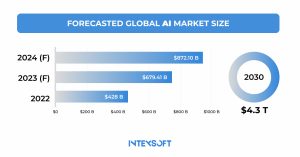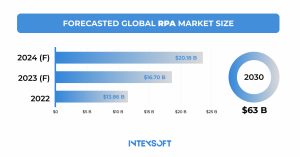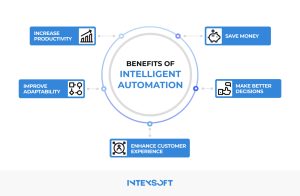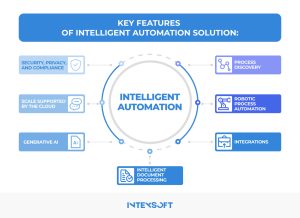Intelligent Business Process Automation: A New Era of Efficiency

Get the lowdown on intelligent business process automation in this article. We’ll uncover the benefits you can expect after implementation and explain how the system works. With its standout features, such solutions are one of the sharpest tools to accelerate your business. Need help navigating tech adoption challenges in intelligent automatization? Contact our experts for tailored solutions.
Reading time: 17 min.
As cloud computing, social media, mobile technology, and AI have reshaped industries, customer expectations have skyrocketed. They now demand better products, personalized experiences, and instant responses. Companies have reacted by digitizing as many manual tasks as possible.


Yet, even with these advancements, employees in organizations both large and small continue to waste time on mundane tasks such as data entry and basic customer queries—precisely the kind of work that should be automated early on.
But now, intelligent automation, a combination of robotic process automation and AI, is upending traditional workflows. Nearly any digital process can be automated, and we argue it’s the smartest step forward.
In this article, IntexSoft focuses on what your business can gain from automation technologies. We will also compare it with robotic process automation.
Consider IPA as a way to enhance almost all business processes intelligently. The secret of this technology lies in the integration of the golden trio:
By close interactions between the three, you elevate and automate complex business processes. While traditional automation merely mechanizes repetitive tasks, IPA deploys AI to sift through vast amounts of data, discern patterns, and execute decisions with a level of adaptability previously unattainable.
This is the basis of the intelligent automation definition. You will learn more details about that in the following part of our article.

Intelligent automation is reshaping productivity strategies for business leaders. For example, a telecommunications company that automated its billing process will see a significant reduction in errors and faster resolution of customer queries. By shifting focus from low-value tasks to strategic initiatives, organizations can adapt more effectively to changing business conditions.
A Deloitte survey reveals that 95% of companies using RPA have seen productivity improvements. This is why we highlight it as a core benefit on our list.
To fully grasp the benefits of intelligent process automation, understand that it can generate long-term cost savings as your business scales and evolves.
Streamlining tasks in your core value chain through automation reduces labor costs and enables employees to concentrate on more strategic initiatives. Over time, this approach enhances ROI and expands your customer base.
The statistics are impressive: companies are seeing 40% in annual savings, and process times cut by up to 70%. It’s hard to ignore the value of intelligent process automation solutions with results like these.
This is the next truly valuable advantage of intelligent automation. The sense is that business leaders and C-level executives gain help to make wiser, data-driven decisions.
This is straightforward to understand. By integrating latest technologies, intelligent automation tools process massive data volumes, uncover trends, and deliver actionable insights instantaneously.
The technology’s prowess lies in its 100% capacity in dissecting complex data sets with great speed. We want to emphasize the moment of speed. Analysis handles any type of data, from customer behavior and sales trends to even market fluctuations. That’s why business leaders can adapt strategies to whatever they want and make informed decisions with speed and enhanced precision.
First of all, you need to understand that many employees who interact with customers find it challenging to provide swift and precise answers to basic questions due to the information being scattered across various applications. The search for these answers often consumes their time, limiting their ability to engage meaningfully with customers or offer additional value.
This challenge can be addressed effectively through intelligent automation. By using software bots to collect and consolidate customer data from multiple sources, these bots can directly answer simple queries and equip employees with a broader understanding of customer needs.
It will be much easier and more straightforward to adapt, adjust, and even readjust to the ever-evolving challenges your business faces with these tech solutions. Imagine it as having a vantage point that allows you to see situations from a higher, broader perspective. You’ll leverage more analytics, make better predictions, and have a clearer understanding of what needs immediate attention. It’s all about the power to be adaptable, confident, and decisive in your solutions. It’s like knowing what will happen next around the corner and being prepared for it.
First of all, to understand why automation business solutions perform so well across different types of organizations, let’s review the table below. It summarizes the AI technologies used by intelligent business automation and provides a concise explanation of each individually.
| Technology | Description |
| Computer Vision | Analyzes and interprets visual data. |
| Natural Language Processing | Understands and processes human language. |
| Machine Learning | Learns from data and improves decision-making. |
| Generative AI | Creates new content or solutions based on learned patterns. |
All AI tools are intricately woven into the fabric of robotic process automation, orchestrating actions and executing process steps with precision. AI technologies meticulously configure the necessary actions, scrutinize the outcomes of business processes to extract actionable insights, and steer RPA on subsequent steps. This process is not static; it’s a dynamic loop of continuous feedback and learning, constantly refining and enhancing operations. Intelligent automation drives this relentless cycle, pushing the boundaries of efficiency.
Intelligent process automation extends its impact beyond this scope and into other areas as well. Are you looking for opportunities to bridge the gap between people, systems, and data? Is it important for you to achieve this effectively and in less time? If these goals align with your business objectives, leverage the benefits of business process automation and the technologies mentioned above.
From initial discovery to full automation and ongoing optimization, intelligent process automation tools effectively bridge gaps and reduce human error.
The key purpose of the technologies highlighted is to enable a continuous cycle of feedback and learning, which can ultimately transform how business operations are conducted.

Process discovery is the core feature driving many organizations to adopt intelligent business process automation and seek out the best outsourcing partners. Let’s delve into what process discovery entails. In simple terms, it is the analysis of operational activities aimed at understanding how processes work across people, systems, and data to identify opportunities for optimization and automation. At this stage, you will gain valuable insights as you uncover red flags that may be causing your business difficulties and leading to profit loss.
Process discovery provides a true picture of an organization’s operations. Are applications and personnel effectively completing workflows? Are processes running smoothly? What are the main obstacles? Where are the bottlenecks hiding?
A business process solution will address the gaps in process execution and help identify risks.
Earlier, we have discussed this point as a crucial element of intelligent process automation services. By automating repetitive digital tasks, RPA lays the groundwork for growth that is scalable and sustainable. It’s a precise and efficient force that replicates human actions across various systems, enabling teams to delegate routine tasks with ease.
When integrated with AI and application programming interfaces (APIs), RPA evolves into a more sophisticated tool. This synergy allows developers to craft comprehensive, end-to-end automation solutions. Think of it as advancing to a new echelon in automation capabilities.
The secret to efficient operations in a fully automated process? System integration. APIs, databases, and applications must align perfectly to form a well-oiled machine. The absence of these critical connections can lead to failures in core processes, undermining the very foundation of the organization’s operations.
Think of integration as the catalyst that drives real-time data flows and actions, ensuring that every part of the system is synchronized and responsive.
Numerous intelligent automation platforms come equipped with pre-existing connectors and packages. IntexSoft strongly advises leveraging these tools. Companies that go for platforms with solid integration tools can fast-track the connection to business applications, pushing the automation build and launch timelines to new levels.
This feature reshapes the landscape for companies burdened by massive document loads.
Picture a business processing hundreds of invoices daily. With enterprise-grade IDP, the company gains critical leverage—automating the extraction, classification, validation, and integration of data directly into their accounting systems. No more manual drudgery.
IDP steps in, cutting through the chaos, reducing human error, streamlining operations, and slashing costs. It is the engine driving precision and efficiency, giving businesses the upper hand in navigating their data-heavy tasks.
Spotting the value of this feature early is crucial, as it opens doors to automating tasks that need human-like decision-making and creativity.
By integrating large language models, intelligent automation can operate at full capacity, helping businesses navigate their operations effectively. Intelligent automation platforms ensure generative AI is used responsibly with strong governance and safeguards.
Employees can utilize natural language to request automations, create customized content, and summarize lengthy documents without leaving their main applications. Additionally, generative AI helps unlock more data from documents.
When scaling your business, intelligent process automation software is your secret weapon. It evolves with your organization, giving executives the tools they need to make decisions from one stage to the next.
This flexibility lets companies handle large workloads efficiently without losing performance. Managing many automations at once is critical for big businesses with complex operations, and cloud-based solutions offer the needed flexibility and scalability. With cloud-native systems, businesses can cut costs on infrastructure, maintenance, security, and compliance. The cloud also provides automatic scaling, continuous updates, and built-in disaster recovery.
A cloud-native SaaS platform makes it easy to extend automation across teams and departments, supporting everyone from regular users to advanced developers.
A top-notch intelligent automation platform should feature a strong security framework, including cloud security, identity and access management, data encryption, and detailed logging. It must comply with industry regulations such as GDPR and offer secure storage solutions. Look for platforms with certifications like ISO 27001 and SOC 1 & 2 Type 2. Audit trails and transparent reporting are vital for accountability, while governance features help control access and changes to automation setups.
RPA is a rule-based automation system that’s transforming how businesses handle repetitive tasks. It uses bots to manage routine work—data entry and document processing—freeing up employees and reducing operational drag. Labor costs can drop significantly, and efficiency sees a notable boost. The beauty of RPA lies in its ease of implementation, often completed within a short timeframe.
Intelligent automation technology goes far beyond the scope of RPA, integrating artificial intelligence and machine learning into its framework. Unlike RPA, which automates tasks, IA adapts and learns from data. This is about a strategic nature.
A closer look at their differences reveals why each may be suited to distinct business needs.
| Category | RPA | IPA |
| Technology | Follows rule-based automation with set instructions. | Uses AI for smarter automation and advanced data analysis. |
| Type of Tasks | Great for repetitive, straightforward tasks (e.g., data entry, file handling). | Handles more complex tasks that require thinking, like fraud detection and sentiment analysis. |
| Data Handling | Works best with structured data like names, emails, or numbers. | Can process both structured and unstructured data like audio, video, or IoT data. |
| Flexibility | Follows rules, not easily adaptable without manual changes. | Learns and adapts using machine learning, so it improves over time. |
| Scalability | Limited when handling more complex tasks or bigger data. | Scales easily to handle large workloads and complex tasks as your business grows. |
| System Integration | Can be integrated into existing systems without major changes. | Needs AI integration and works with multiple data sources, which may take more setup. |
| Best for Tasks Like | Perfect for automating simple, repetitive tasks. | Ideal for tasks that need insights, problem-solving, or decision-making. |
| Automation Reach | Works well for specific tasks within one department. | Designed to automate and connect processes across multiple teams or departments. |
| AI Integration | Doesn’t include AI or learning capabilities. | Built on AI, which helps it learn and adapt to new challenges. |
| Data Use | Works with defined, structured data sets. | Analyzes both structured and messy, unstructured data for more dynamic tasks. |
| Compliance | Limited when it comes to handling complex compliance needs. | Can tackle more sophisticated regulatory requirements, especially in industries like finance or healthcare. |
| Cost & ROI | Lower initial cost and easier to implement. | Higher upfront cost, but delivers better ROI by automating complex, value-added processes. |
If the advantages of the intelligent automation RPA above have captured your attention, consider this your invitation to connect with us. At IntexSoft, our experts possess extensive experience in deploying these solutions across a diverse array of industries.
Engage with us for a thorough discussion. We’ll provide you with detailed examples, answer any questions you might have, and offer advice tailored specifically to your needs. Begin your path to improved efficiency and a stronger competitive position today.